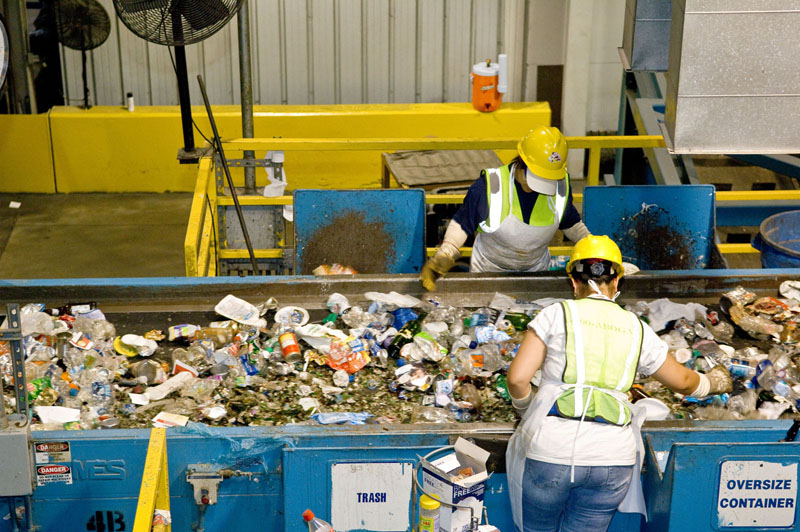Pyrolysis: An Alternative Plastic Recycling Scheme
The traditional mechanical recycling is based on melting and reforming plastic into other items. However, to do this, materials need to be sorted by polymer and colour which could be quite expensive for the industry. The existence of contaminants could lead to polymer degradation and could result in materials that have inconsistent properties which could be useless to the recycling industry. Another issue is that, thin film materials also are not generally collected in the normal mechanical recycling schemes since mechanical recycling has difficulty in recycling them. It would be useful to find other recycling schemes which can handle thin plastic films. With increasing demand, mechanical recycling alone can not figure 1, shows a traditional mechanical recycling facility.
 Figure 1: Mechanical Recycling Plant
Figure 1: Mechanical Recycling Plant
Pyrolysis is an alternative is a thermochemical process of breaking down plastic waste at high temperatures in the presence of low oxygen to produce pyrolysis oil which can be used as a fuel to make new plastic products1. It is a replacement for fossil fuel feedstock for plastic production. One of the products of plastic pyrolysis is hydrogen gas which is very much in demand for hydrogen fuel industry2.
To create quality output that is suitable to be presented to the market, there are certain threshold values that need to be taken into consideration for each type of plastic and the contaminants1. The raw material for pyrolysis recycling needs to be well sorted and free of contamination as much as possible. All items should be free of contents and free flowing liquids and should be rinsed properly. The general guidelines are to have a minimum of 85% of polyethylene (LDPY, HDPE) and polypropylene (PP). The moisture content should be a maximum of 7% and the maximum total contamination should be a maximum of 15%. This is total maximum percentage of contaminants but there are also limits on individual contaminants. These are listed below
- PVC: 1
- PET/PVOH/Nylon: 5%
- PS: 7%
- Rigid metal/glass/dirt :7%
- Paper/organics: 10%
Figure 2 shows a pyrolysis recycling facility

Figure 2: Pyrolysis plant
There are basically three main products of plastic pyrolysis which are:
- Pyrolysis Oil
- Carbon Black
- Non-condensable gas
Each of these products and their usage are described below:
Plastic Pyrolysis Oil
Pyrolysis oil is the main product of plastic pyrolysis. This oil can be used in turbine engines, industrial boilers and fixed RPM machines such as generators. It can also be further processed into diesel fuels which can be used in diesel vehicles. This process will reduce plastic waste and generate fuel which is a win-win situation
Carbon Black
The next important product of plastic pyrolysis is carbon black which is a black powder. This powder can be turned into pellets which can be burned similar to coal. It is advised not to do so because as it is well known that coal is a one of the most polluting fuels for creation of green house gases. However, if Carbon Capture and Sequestration (CCS) systems are in place, it can be used as a fuel. It is also possible to make new types of plastics using carbon black which is quite a useful application
Non-condensable gas
This gas which is the product of pyrolysis can be reused in the pyrolysis process and is basically is used as recycled energy.
Pyrolysis recycling operators need well sorted, clean and highly homogeneous Polypropylene (PP) and Polyethylene (PE) raw material (Reference 1). Here is where near-IR spectroscopy can help these operators to sort different plastics. ASP laser Inc. offers the Nirvascan spectrometer which can measure the reflectance spectrum from a plastic in the range 900-1700 nm and also other extended ranges (1350-2150 nm and 1600-2400 nm). The reflectance can be converted into absorption and using a classification model such as Linear Discriminant analysis, different types of plastics can be sorted. Figure 3 shows a typical plastic reflectance measurement using the reflective model of Nirvascan.
 Figure 3: Nirvascan measurement from a PVC plastic
Figure 3: Nirvascan measurement from a PVC plastic
Nirvascan absorption measurement can be turned into a Linear Discriminant Analysis model which can distinguish between different types of plastic. Figure 4 shows the LDA model.

It needs to be explained that the above LDA model was generated using the measurements of the extended range Nirvascan with a spectral range of 1350-2150 nm and not the standard one which works in the 900-1700 nm range. The reason is only the distinction between HDPE and LDPE which is only possible at wavelengths slightly larger than 1700 nm which is not covered by the standard Nirvascan but is with the extended version.
To summarize, pyrolysis accomplishes two targets which are reducing plastic waste and also generating new plastics or fuel from recycled material.
References
1- Feedstock quality guidelines for pyrolysis of plastic waste, Eunomia, August 2022.
2- Feasibility of gasifying mixed plastic waste for hydrogen production and carbon capture and storage, K.Lan, et.al, communications, Earth and environment 2022.
4- Cover Picture: https://www.plastictooilmachine.com/FAQ/products_of_waste_plastic_pyrolysis_plant140.html